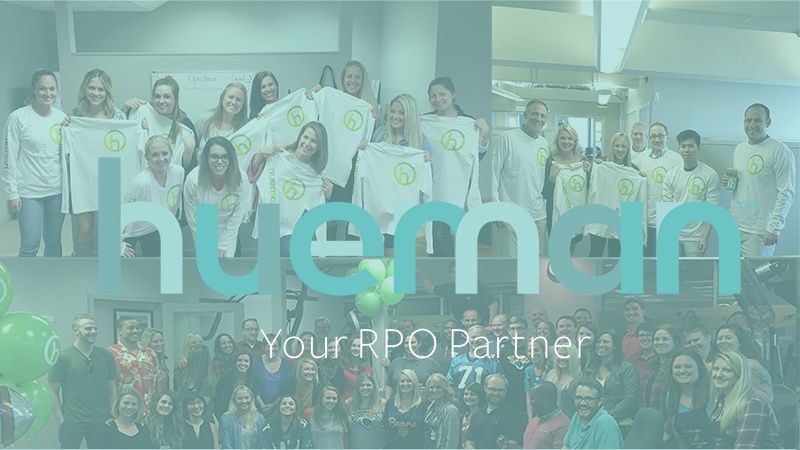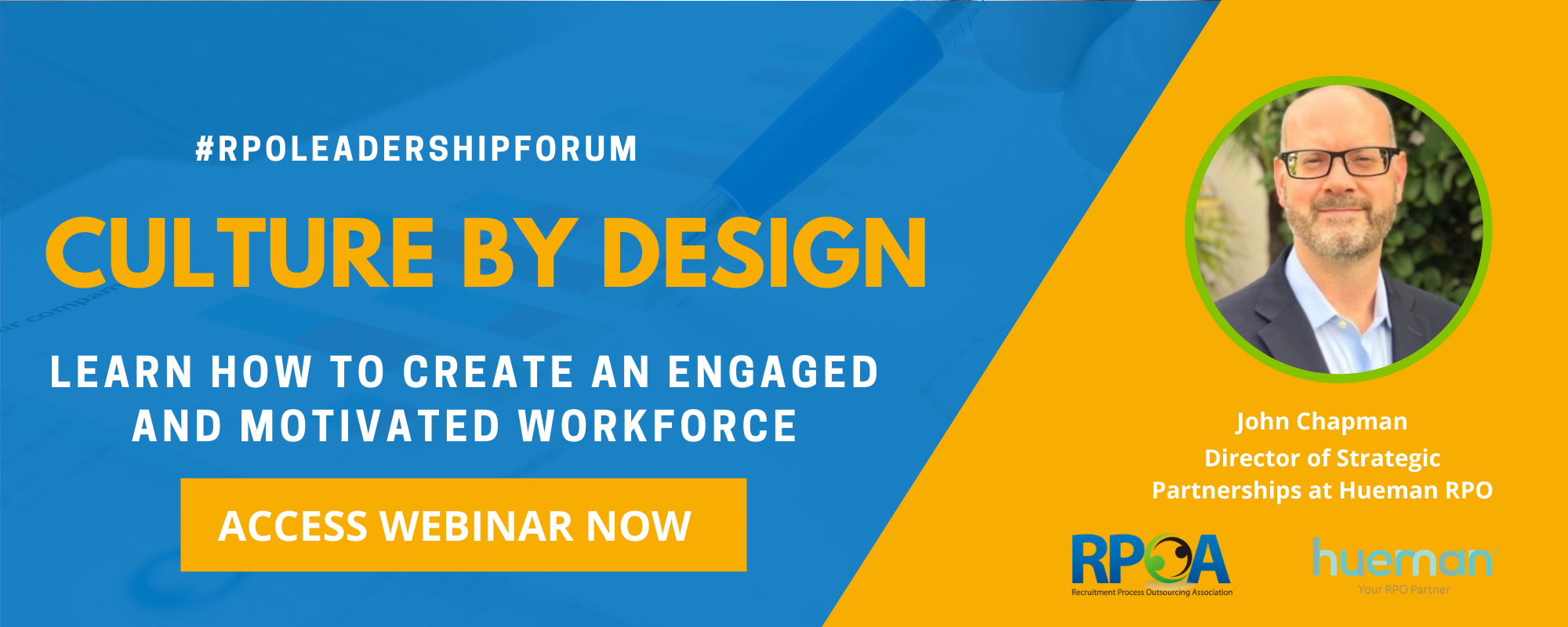
Today, companies that want to be successful need to be more intentional in creating a flourishing workplace culture. Hueman RPO has instituted “culture by design” that takes intentional workplace culture-building to the next level. It shows a high value in designing a thriving culture in its hiring process. To make sure it hires the top talent who fits into its culture, Hueman interviews candidates up to seven times and talks with them for two hours during the last panel-style interview before making a final hiring decision.
In the latest edition of RPOA's Leadership Forum webinar, John Chapman, Director of Strategic Partnerships at Hueman RPO, talks about his positive journey through Hueman’s hiring process and his experience working in a culture by design. Chapman’s presentation helps attendees understand the value of culture and engagement in gaining organizational success.
From his presentation, viewers will understand the importance of intentionally creating a positive workplace culture. His central proposition is that leadership buy-in, a core ideology, communication, hiring top talent, and transparency are the key areas to focus on to develop a culture by design. Team engagement is also vital to an intentional culture, and Chapman finishes up the webinar with some practical ways to help your company increase your team engagement.
A Living Case Study of Culture by Design
A workplace with a good culture will have work teams that thrive. At Hueman, Chapman said, "The key to our success is our people, and our teams thrive because of our culture." After a year and a half at Hueman, "I feel like I'm living in a real case study, honestly, a real-life case study on the value of culture," he said.
Chapman's introduction to Hueman's living case study of culture by design happened on his first day. On his first day of orientation, his future teammates greeted him with a pile of handwritten cards from people that work at Hueman. He said that there were notes of thanks, notes of encouragement, and notes of welcoming. Chapman said, "It couldn't have started things better for me at Hueman than to have those welcoming notes."
Chapman next pointed out that it's helpful to remember what Peter Drucker famously said about culture when evaluating your own culture. Drucker said that culture eats strategy for breakfast. His statement, Chapman said, "simply means that it’s great to have a company strategy. But if you have that without culture, you're ultimately missing out on a lot."
Chapman highlighted John Kotter's book Corporate Culture and Performance to note some things companies miss out on when their strategy lacks culture. Overall, strategy without culture causes companies to miss out on having a culture that thrives. He said that companies without a thriving culture miss out on things like increased revenues, happy and productive employees, and increased customer satisfaction, to name a few. As a person amid a thriving culture, Chapman said, "I definitely see a higher contribution margin, people are excited to contribute, and ultimately, that increases our profits. And that also increases customer satisfaction."
Five Components of Culture by Design
After discussing the importance of culture and his experience working within a flourishing culture, Chapman went on to talk about the five critical ingredients to creating culture by design. These are the same ingredients Hueman uses to build its intentional culture, and Chapman recommends them to all companies that want to create a thriving culture. Those five ingredients for a culture by design are leadership buy-in, a core ideology, communication, hiring top talent, and transparency.
1) Leadership Buy-In
Leadership Buy-in is vital to building a culture by design. Chapman pointed out that his friend Rick Newton over at the Newton Institute built on Drucker's famous statement. Newton said that if culture eats strategy for breakfast, then leadership eats culture for lunch. Chapman said Newton is saying, "that if you have a culture, you must have a leadership team that ultimately is really communicating that effectively through your organization."
Chapman said, "At Hueman, we see this firsthand through our founder and CEO, Dwight Cooper. Cooper has his focus on culture "not just every day or every week, it's all the time," he said.
Chapman said three things that he sees Cooper and Joe Marino, Executive Vice President of Hueman, do to show leadership buy-in and ensure "the culture is breathing throughout the entire organization." Those three things: giving credit where credit is due, showing genuine interest, and continually reinforcing our values. Chapman believes that these are three things the leadership of any company can do to show buy-in.
"I have to tell you that without leadership buy-in culture probably is going to fall flat," Chapman said. "And this shouldn't just be an agenda item for you. It should be something that you're living and breathing."
2) Core Ideology
Chapman then moved on to core ideology. He defined core ideology as "your core purpose. It is who you are." He pointed out that once a company knows its core ideology, it can establish its core values. And Chapman noted that a company could perpetuate those core values throughout the organization. Chapman said, "One way you can perpetuate the core ideology is by evaluating prospective employees during the hiring process, looking at them through the lens of your core ideology and your core values.
3) Communication
The next component to creating culture by design Chapman discussed was communication. He broke down this factor into three types of communication. They are top-down communication, bottom-up communication, and lateral communication.
Read the story: Hueman's Culture-Based Recruiting Model Powers Strategic RPO
Top-Down Communication
Chapman defined top-down communication as "A platform for the senior leadership to communicate to those that they're leading." Chapman explained some examples of how Hueman exhibits good top-down communication. Examples he spoke about include 831 meetings and quarterly town halls.
A 831 meeting "is the opportunity for one of our managers, one of our team leads to present all of the information for that week," he said. "It could be statistics on partnerships that we're serving, it could be results on a recent survey that we've taken in the company. It could be an update on one of the committees that we're talking about. It could even be financially updating us regarding the company's performance."
Chapman said town hall meetings are "where our CEO and founder Dwight Cooper takes some time to really open up and share from his heart where we are as a company, what's working, what's not working, the good, the bad and the ugly."
Bottom-Up Communication
Chapman went on to define bottom-up communication as "a platform for individuals to share with senior leadership." He said, "During those town halls, we are given a live q&a opportunity where we can put Dwight on the hot seat and say, okay, Dwight, what about this? Or what about this?" Chapman emphasized that Dwight welcomes those opportunities to answer any questions. "Of course, we have one-on-one’s. We have team meetings. We have off-site meetings," he added.
Lateral Communication
Chapman's third element is lateral communication. He said, "This is where peer-to-peer communication might come in. When you have peers communicating with each other, now there's some real power in that." Chapman pointed out that Hueman uses 831 meetings, Zoom, and 15 fives to deploy peer-to-peer communication. He said that the 15 fives platform allows team members to talk about how they're feeling, give shout-outs, and let their peers know who excels at exhibiting their core values. "We're getting this real-time feedback from our team to make sure that we're communicating with each other," Chapman said. "We're hearing from our senior leadership, but we're also sharing up as well."
4) Hiring: The Value of Recruiting Passive Candidates
Talent affects culture, and when it comes to hiring top talent, Hueman doesn't mess around. Most companies recruit active candidates. Those are the folks looking for new opportunities. The opposite of those folks is passive candidates. Passive candidates aren't actively looking for new opportunities but might be willing to talk to a recruiter. Chapman said, "Hueman is brilliant at going after the passive candidates." He points out that's how Hueman hired him.
Earlier in the webinar, Chapman mentioned one way a company can perpetuate its core ideology is through its hiring process. He pointed out that a company can evaluate a prospective candidate through the lens of its core values through the hiring process. Chapman experienced this kind of evaluation during his panel interview with Hueman that lasted about two hours. "I've seen this be very effective for interviewing within the Hueman team," he said.
Chapman explained that the panel interview format is a process where the interviewers take the candidate back to high school and ask what was successful for them. What challenges did they have? He said that then the interviewers move onto college and ask the same kinds of questions. They then will start asking about "jobs and specifically ask questions relating to individuals that were on their team, as well as people that were supervising them," Chapman added.
Chapman said of the panel interview process, "there's actually a truth serum in this, that as we're asking these very pointed questions and saying the name of their peer or boss, the truth begins to bubble up when you're asking somebody, not just Hey, what did you think of that job? But hey, who is your supervisor? And what was his name? And what did he think of you?" He added that as a result of asking pointed questions, "oftentimes, that's going to cause more times than the truth to bubble up so that we can really get an idea of what those success factors were for that individual."
5) Transparency
The last vital element to building a culture by design Chapman talked about was transparency. To Chapman and Hueman, transparency in the context of culture means that Hueman has an open book management approach. "It means that we're providing consistent transparency when it comes to the financials of our company in our quarterly meetings that Dwight holds," Chapman said. "He's giving, the good, the bad, the ugly. He's letting everybody into what's going on behind the doors of Hueman. And ultimately what this does as a result of our leadership's honesty and transparency, they earn the trust of the employees and we can trust that they're telling us the truth, when they show us the performance of the various divisions, the P&L and everything else that's going on. Transparency is absolutely key."
Employee Engagement and Culture
After hitting on the five key elements of building a culture by design, Chapman outlined some practical ways companies can engage their teams.
"You know, the key components, those five key components of a culture by design, really are not complete without engagement and engagement and culture intertwine," Chapman said. "If you have a great culture, you likely have an engaged employee workforce as well. And if you don't have some solid company culture, then you likely lack engagement." He defined employee engagement as "the emotional and functional commitment that an employee has to his or her organization."
"According to Gallup, highly engaged teams show 21% greater profitability. And those teams who score in the top 20% in engagement, realize a 41% reduction in absenteeism, 59% less turnover," Chapman said. "So there's no question that when an engaged employee shows up, they're passionate, they're full of purpose, they're present, and they bring energy."
Chapman pointed out that the surest ways to employee engagement are recognition, delegation, and leadership opportunities.
Recognition
Chapman said that Hueman does many things well that have gained successful employee engagement. But he said that the one thing that stands out the most as effectively promoting employee engagement is recognition. Chapman told the story of how Hueman recognized him for his excellent work. "About three months ago, when I was able to introduce a new partnership to Hueman. My direct lead, contacted me and said Congratulations, Joe quickly followed with an email, maybe a phone call, actually of Congratulations, Dwight Cooper, the CEO, called me personally to congratulate me, the entire leadership team reached out via email to congratulate me, then in our team meeting during the week, I was congratulated and encouraged. And then finally, on our 831 team meeting, the entire company recognized me and thanked me for the opportunity to serve another partner."
Delegation and Leadership Opportunities
Chapman said that Hueman fosters an environment of trust through delegating and providing leadership opportunities within committees. "We have a bunch of those within Hueman; core values committee, a community service committee, DEI, wellness, 401k," he said. "All of those things are actually specifically gauged by metrics, we hold those to metrics, and it gives people an opportunity, a unique opportunity. One to get plugged into things that they're passionate about. Two, they're able to lead. And three, they're able to communicate effectively the core values that we hold so near and dear to our heart."
Culture by Design Sustains Business in a Time of Crisis
"A culture by design really sustained our business in times of crisis," Chapman emphasized. "In fact, we embraced it, we leaned on our culture more than we ever have in the past. One of the things that really stood out to me was what we call our human stimulus plan, where Hueman gave each of the employees in the company--over 200 people--a cash incentive of $150. And the design was to use that money specifically at a local business in your community that was struggling. So the idea was to infuse the community with this money."
Chapman emphasized that there's the service element that permeates Hueman in our culture. "And if you're wanting to know how to survive in a crisis, culture and engagement are absolutely one of the things that will get you there," he said.
We hope this webinar helps you understand how to create a culture by design at your company.
Download Hueman's World-Class Recruitment Guide, including Best Practices, Strategies & Tips to Improve Your Company's Recruitment Process & Attract Top Talent
Perhaps this discussion validated some things you and your company are currently doing in regards to culture. Either way, we invite you to join this discussion and others like it to help you and your company create a thriving culture.















